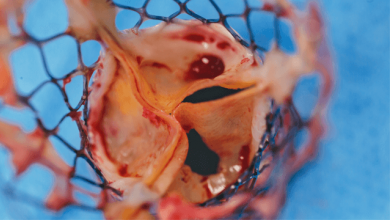Search results
PROMOTED
Author(s):
Nicolas M Van Mieghem
,
Kendra J Grubb
,
David Hildick-Smith
,
et al
Start date:
Mar 26, 2024
Author(s):
Holger Eggebrecht
,
Axel Schmermund
Added:
3 years ago
Transcatheter aortic valve implantation (TAVI) has become a highly effective and beneficial treatment option for patients with severe symptomatic aortic valve stenosis. The randomized Placement of AoRtic TraNscathetER Valves (PARTNER) trials have shown that (1) TAVI using the balloon-expandable Edwards Sapien valve implanted via the transfemoral (TF) or transapical (TA) route is superior with…
View more
Author(s):
Jonathan A Mailey
,
Patrick Thompson
,
Paul W Johnston
,
et al
Added:
1 year ago
Foreword
Author(s):
Simon Kennon
Added:
3 years ago
Article
Annular Rupture During TAVI
Author(s):
JJ Coughlan
,
Thomas J Kiernan
,
Darren Mylotte
,
et al
Added:
3 years ago
Article
BCIS TAVI Statement
Author(s):
Philip MacCarthy
,
Dave Smith
,
Douglas Muir
,
et al
Added:
3 years ago
Article
Author(s):
Crochan J O’Sullivan
,
Peter Wenaweser
Added:
3 years ago
Since the first ‘proof-of-concept’ case of transcatheter aortic valve implantation (TAVI) was reported by Cribier and colleagues in 2002, more than 200,000 patients have undergone the procedure in approximately 65 countries.1,2 Since its inception, the majority of patients undergoing TAVI have been considered inoperable or high risk for conventional surgical aortic valve replacement (SAVR) as…
View more
Author(s):
Daniel S Menees
,
Eric R Bates
Added:
3 years ago
Nearly one-third of the approximately 30 million people undergoing non-cardiac surgery in the US each year have known coronary artery disease (CAD) or CAD risk factors.1,2 An estimated one million suffer peri-operative cardiac complications accounting for roughly US$20 billion in annual medical costs.3 Peri-operative myocardial infarction (MI) may affect as many as 34% of high-risk individuals…
View more
Author(s):
Nilesh Pareek
,
Peter Kordis
,
Ian Webb
,
et al
Added:
3 years ago
Out-of-hospital cardiac arrest (OHCA) is defined as the sudden absence of cardiac mechanical contractility with loss of signs of circulation that occurs within a community setting.1 OHCA affects more than half a million patients globally per year and is one the leading causes of death in developing countries.2 In the US, OHCA affects 350,000 patients per year and is the third leading cause of…
View more
Author(s):
Göran K Olivecrona
,
Marko Noc
Added:
3 years ago
Although approximately 2,000,000 patients undergo PCI yearly worldwide, only a very small minority will suffer a protracted cardiac arrest episode during the procedure that results in death.1 Cardiac arrest itself in the catheterisation laboratory (cath lab) is not an uncommon event, but is usually rapidly resolved with cardiopulmonary resuscitation (CPR) and DC conversions in cases of…
View more
















